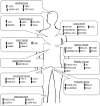Long non-coding RNAs regulation of therapeutic resistance
- PMID: 35582574
- PMCID: PMC8992514
- DOI: 10.20517/cdr.2019.58
Long non-coding RNAs regulation of therapeutic resistance
Abstract
Non-protein coding RNAs have emerged as a regulator of cell signaling and cancer progression through regulation of cell proliferation, metastatic burden, and cancer stem cell capacity. A subtype of non-protein coding RNA is long non-protein coding RNA (lncRNA). Besides their aforementioned roles in cancer cell biology, dysregulation of lncRNAs contribute to resistance to therapeutic treatments. A couple of important therapeutic classes are chemotherapy and targeted/hormone therapies. This review highlights the variety of malignancies affected by lncRNA dysregulation and the underlying mechanism causing therapeutic resistance.
Keywords: Long non-protein coding RNA; and microRNA sponge; cancer; chemotherapeutic resistance; hormone therapy; target therapeutics.
© The Author(s) 2019.
Conflict of interest statement
All authors declared that there are no conflicts of interest.
Figures
Similar articles
-
Coding roles of long non-coding RNAs in breast cancer: Emerging molecular diagnostic biomarkers and potential therapeutic targets with special reference to chemotherapy resistance.Front Genet. 2023 Jan 6;13:993687. doi: 10.3389/fgene.2022.993687. eCollection 2022. Front Genet. 2023. PMID: 36685962 Free PMC article. Review.
-
The decalog of long non-coding RNA involvement in cancer diagnosis and monitoring.Crit Rev Clin Lab Sci. 2014 Dec;51(6):344-57. doi: 10.3109/10408363.2014.944299. Epub 2014 Aug 15. Crit Rev Clin Lab Sci. 2014. PMID: 25123609 Review.
-
LncRNA-ATB: An indispensable cancer-related long noncoding RNA.Cell Prolif. 2017 Dec;50(6):e12381. doi: 10.1111/cpr.12381. Epub 2017 Sep 8. Cell Prolif. 2017. PMID: 28884871 Free PMC article. Review.
-
Long non-coding RNAs: Mechanism of action and functional utility.Noncoding RNA Res. 2016 Nov 12;1(1):43-50. doi: 10.1016/j.ncrna.2016.11.002. eCollection 2016 Oct. Noncoding RNA Res. 2016. PMID: 30159410 Free PMC article. Review.
-
LncmiRSRN: identification and analysis of long non-coding RNA related miRNA sponge regulatory network in human cancer.Bioinformatics. 2018 Dec 15;34(24):4232-4240. doi: 10.1093/bioinformatics/bty525. Bioinformatics. 2018. PMID: 29955818
Cited by
-
The SOX gene superfamily in oncogenesis: unraveling links to ncRNAs, key pathways, chemoresistance, and gene editing approaches.Naunyn Schmiedebergs Arch Pharmacol. 2025 May 20. doi: 10.1007/s00210-025-04229-1. Online ahead of print. Naunyn Schmiedebergs Arch Pharmacol. 2025. PMID: 40392306 Review.
-
Non-Coding RNAs: Uncharted Mediators of Thyroid Cancer Pathogenesis.Cancers (Basel). 2020 Nov 4;12(11):3264. doi: 10.3390/cancers12113264. Cancers (Basel). 2020. PMID: 33158279 Free PMC article. Review.
References
Publication types
LinkOut - more resources
Full Text Sources

